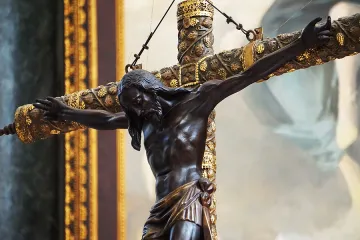Madrid, Spain, Oct 8, 2024 / 07:00 am
Spain has 3,500 beatified martyrs from the religious persecution of the 20th century and another 4,000 could also be beatified in the coming years, according to Father José Carlos Martín de la Hoz, a priest who is an expert in these processes.
“A few months ago, at the request of the Dicastery for the Causes of Saints, a survey was taken, speaking with all the delegates of the Causes of Saints of all the dioceses, and a list of another 4,000 possible blesseds was made,” he said.
“When this work is finished, which we will finish in four years, there will be 7,500 martyrs, blesseds on our altars,” explained Martín de la Hoz, director of the Office of the Causes of Saints for Opus Dei.
The priest made the prediction during the presentation in Madrid of the book “Hogares de amor y perdón II” (“Homes of Love and Forgiveness II”), published by the Enraizados en Cristo Association (“Rooted in Christ”), which contains the testimony of 23 families who were noted for the dedication and fidelity of their members to the point of giving their lives.
Martín de la Hoz emphasized that “what is most impressive is that those 7,500 martyrs, blesseds, their martyrdom is documented, that is, they died out of hatred for the faith and it is documented that they died forgiving.”
In his talk, the expert also explained that “the first dicastery to be opened in Christianity, in the Church, is the Dicastery for the Causes of Saints,” as can be seen in the Acts of the Apostles, where it is stated that “the first decision taken by the Church is to preserve the memory of the martyrs.” Not without reason, during the time of the first Christians, “Mass was celebrated on the tombs of the martyrs,” he added.
Origin of the 20th-century religious persecution in Spain
Martín de la Hoz explained how studying the causes of the martyrs of the 20th century leads to considering that “it all began in the Cortes of Cadiz” in 1812, whose constitution begins by saying “‘in the name of the Father, the Son, and the Holy Spirit,’ but then what is established and delineated is what was called liberalism.”
During the 19th century, “the progressive liberals and the conservative liberals alternated being in power, but in the end what unites them is a very violent persecution against the Church. It’s as if all the Enlightenment and the French Revolution that had happened in central Europe suddenly appeared in Spain.”
“This hatred that is present, that is spreading, that is constant and continuous, is penetrating” the strata of intellectuals, of workers, in the countryside, all the way up to the times of the Second Republic (1931–1936), he said.
The outbreak of the Spanish Civil War was, in the expert’s opinion, “the emergence of something that was already in motion, because it had been unfolding for a century. That is why it is very important to return to the memory of the martyrs, because they are the ones who are going to help us rebuild a united society.”
An example of forgiveness
Among the testimonies of forgiveness compiled in “Hogares de amor y perdón II,” there is one offered by Luis García Chillón, who remembers his uncle, Hermenegildo Chillón Cabrera, martyred in the town of Talavera de la Reina in Toledo province, Spain.
Mere, as he was known in the area, was a town watchman and at the age of 29 he was dismissed by the mayor, Francisco Cancho, a member of the Popular Front. One night in February 1936, 20 men beat him up and left him half dead.
He spent 12 days in the hospital and when he was released, he tried to recover in Tarancón in Cuenca province. After the start of the war in July 1936, they went looking for him to imprison him in the convent of the nuns known as “Ildefonsas.” It was Aug. 22.
After a summary trial by the so-called “people’s committee,” he was taken out of the place in handcuffs and a cowbell was hung around his neck while they deliberated whether to burn him or shoot him. Finally, they took him to the place of his martyrdom. Before dying, he asked his executioners to give his wallet to his mother with these words: “Give her a hug and another one for yourself, so that you [the executioner] may forgive me if I failed you in any way.”
(Story continues below)

His nephew Luis believes that “at the moment of truth, when these words are said, they are felt deeply and imply a tremendous greatness of spirit.” From these words he deduces, despite not knowing his uncle, “that this man forgave those who were martyring him.”
For him, “this shows a unique greatness of heart” and makes it clear that, regardless of the religious practice that his uncle had, “the blood of the martyrs cleanses everything, heals everything.”
He also noted that “in my Uncle Hermenegildo’s family there was never any talk of hatred or resentment” and that today the relatives of the martyrs “have no desire to settle any score or any desire for revenge or anything like that. But we cannot allow them to be forgotten either.”
This story was first published by ACI Prensa, CNA’s Spanish-language news partner. It has been translated and adapted by CNA.






